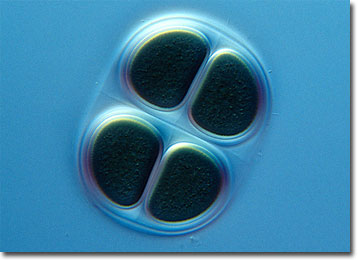Wim van Egmond
Chroococcus Cyanobacteria
Once commonly known as blue-green algae, the large group of primarily photosynthetic prokaryotes that exhibit morphology similar to the eukaryotic algae have been reclassified and termed cyanobacteria. As do all prokaryotes, cyanobacteria lack a membrane-bound nucleus, as well as chloroplasts, mitochondria, a Golgi apparatus, and an endoplasmic reticulum.

Chroococcus is a large genus of cyanobacteria whose species are difficult to differentiate. However, they are typically characterized as living in small colonies of 2, 4, or 8 cells that are surrounded by a clear, mucus sheath. Occasionally unicells or colonies with as many as 16 individuals may occur as well. The sheaths of Chroococcus colonies are sometimes moderately stratified or layered, as demonstrated by C. turgidus, which is most often found in soft water habitats frequented by desmids. Also, the cytoplasm of the cells contains photosynthetic pigments and may exhibit a granular texture.
Though they are extremely tiny, cyanobacteria have played an immensely important role in making the Earth inhabitable for other life forms. Working in conjunction with primitive bacteria, for instance, the organisms helped change the planetís environmental makeup by annexing significant amounts of atmospheric carbon for photosynthetic processes, making way for the presence of free oxygen in the atmosphere. Furthermore, cyanobacteria accelerated this massive change by becoming the first organisms to utilize water as a source of electrons and hydrogen for photosynthesis, a process that results in the release of free oxygen. The accrual of this oxygen eventually facilitated the evolution of a host of new organisms reliant on oxygen for life.
BACK TO WIM VAN EGMOND GALLERY
